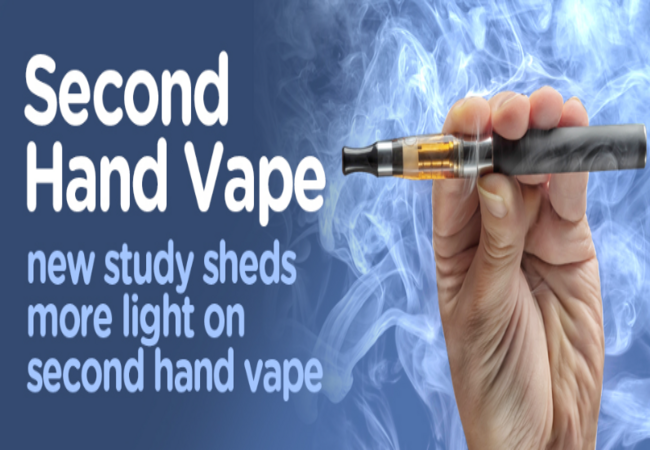As people around smokers breathe in secondhand smoke, secondhand vape those near someone vaping may also inhale their vapor. The vapor, technically an aerosol, contains chemicals such as nicotine and diacetyl, which can irritate the airways. While short-term studies haven’t shown that exposure to e-cigarette vapor hurts lung function; more research is needed on its long-term effects, particularly for children.
What is E-Cigarette Vapor?
Vaping is when you use a device (such as an e-cigarette, vape pen, vaporizer, or mod) to inhale tiny nicotine particles and flavoring from liquid heated into a mist. E-cigarettes and other ENDS, including e-hookahs, tank systems, and mods, can look like regular cigarettes, cigars, or pipes or have features that make them stand out. They may have a mouthpiece or a tank system that can hold and refill liquid solution with different flavorings, nicotine levels, and other ingredients (e-liquid). The most common e-liquids contain nicotine derived from tobacco or synthetically, as well as vegetable glycerin and propylene glycol. Nicotine is addictive and may harm the developing brain of teens. Studies also show that teenagers who use e-cigarettes are more likely to want to smoke regular cigarettes and other tobacco products.
E-cigarette vapor contains harmful chemicals, including carcinogens, and can cause breathing problems, lung damage and even heart disease. It can irritate the throat and mouth and cause nausea, cough and vomiting. It can also worsen respiratory conditions, such as asthma, and increase the risk of a lung infection. The aerosol or vapor released by e-cigarettes can also cling to surfaces and furniture and cause secondhand vape exposure for those in the room with the smoker. It can be smelly and pollute indoor air. There are also reports of e-cigarette batteries exploding while being charged.
What Are the Health Risks of E-Cigarette Vapor?
The vapor from e-cigarettes contains nicotine and potentially harmful chemicals and metals that can cause lung damage. It may be why the use of alternative tobacco products is associated with an increase in a serious type of lung disease. This illness occurred in the United States in 2019, and many victims reported previous vaping. E-cigarettes contain an inner secondhand vape battery-powered chamber that heats a liquid called e-juice to create the vapor you see when someone vapes. This vapor has been found to have dangerous chemicals, including aldehydes like formaldehyde and metals like nickel, tin and lead. It also has volatile organic compounds, such as propylene glycol and diethylene glycol (used in food additives, antifreeze and paint solvent), and smog components secondhand vape like benzene and ultrafine particles.
While the amount of these toxicants is much smaller than in tobacco smoke, it can still be bad for your health if you are around someone who vapes regularly. According to a study, being around vapor can increase the likelihood of young bystanders experiencing bronchitis symptoms and shortness of breath. Even when smokers and vapers stop smoking or vaping, some chemicals they release remain indoors for a long time. They can settle on surfaces like windows, walls, and floors and become dust or inhaled. These chemicals can also react with other substances to produce new chemicals that harm your health.
What Can I Do to Avoid E-Cigarette Vapor?
Vaping products emit aerosol and contain chemicals that are harmful to people. These chemicals can include nicotine, which is addictive, and cancer-causing tobacco-specific nitrosamines. These are the same toxins found in secondhand smoke. Infants and children, pregnant women and people with lung conditions are more susceptible to harm from exposure to secondary e-cigarette aerosol. They can also be exposed to diacetyl, a chemical that impairs the function of cilia in the airways.
Short-term exposure to e-cigarette vapor probably isn’t that dangerous, but it should be avoided. There need to be more studies to know if long-term exposure is harmful. E-cigarettes don’t produce side stream smoke, so they don’t release the same toxicants as cigarettes. The exhaled vapor only contains a fraction of the substances inhaled, and most of the vapor dissipates quickly.
When a person vapes, the chemicals in secondhand vape the aerosol don’t just escape into the air; they can also settle on surfaces like furniture, carpets, curtains, walls and bedding. These chemicals can then release more vapor or react with the characters to form other compounds. Ventilation, filtration and air cleaning can help reduce these exposures but cannot eliminate them. Nicotine is especially harmful to kids’ developing brains. It can affect their memory, mood, concentration and self-control. It can also increase their risk of becoming a smoker later in life.
How Does E-Cigarette Vapor Enter Your Lungs?
Inhaling the vapor from an electronic cigarette introduces nicotine and other chemicals into your lungs. These chemicals can harm you in many ways. Unlike cigarettes, which burn secondhand vape tobacco to produce smoke, e-cigarettes heat the liquid to make an aerosol. Because e-cigarettes have been around for a shorter time than cigarettes, we have yet to determine what long-term health effects they may have. Besides nicotine, the vapor from ESDs can contain harmful chemicals and ultrafine particles. The vapor can also contain volatile organic compounds, which cause eye, nose and throat irritation at high concentrations. It can also include metals like nickel, tin and lead.
The vapor from e-cigarettes can trigger asthma and make breathing problems worse. It can also lead to lung damage, including scarring that can block the tubes that bring air in and out of your lungs. Some lung damage caused by vaping can heal, but some are permanent. It is why it’s important for schools, workplaces and other places that are 100% smoke-free to include e-cigarettes in their smoke-free policies. It will prevent non-users from inhaling secondhand vapor and potentially harming their health. This policy is especially important for teens because their lungs are still developing and are at greater risk for permanent damage.




